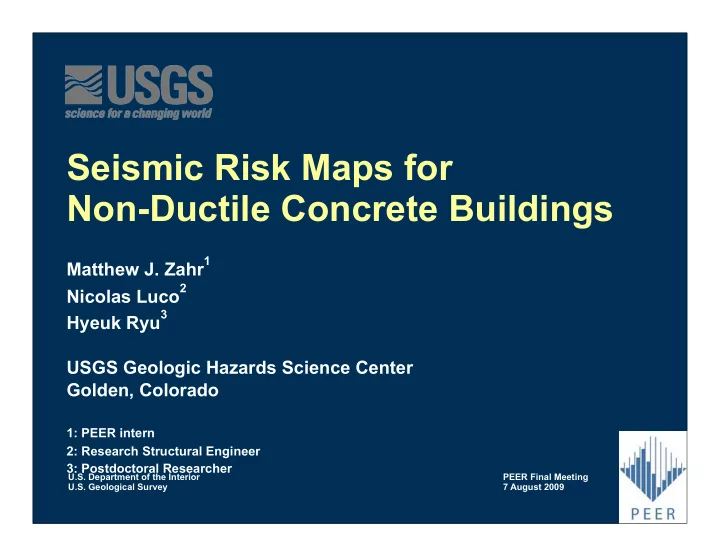

Seismic Risk Maps for Non-Ductile Concrete Buildings 1 Matthew J. Zahr 2 Nicolas Luco 3 Hyeuk Ryu USGS Geologic Hazards Science Center Golden, Colorado 1: PEER intern 2: Research Structural Engineer 3: Postdoctoral Researcher U.S. Department of the Interior PEER Final Meeting U.S. Geological Survey 7 August 2009
Motivation of Risk Maps Outline To prevent catastrophic failures, concrete buildings built prior to the building code revision in Motivation 1976 are in need of seismic retrofit Risk Given the quantity of these buildings, a systematic Risk Maps method to identify the highest risk buildings is Case Studies desired Closing
Seismic Risk Maps Outline Contour/Raster Maps Several types to be discussed Motivation General Risk Map Risk Inventory-Specific Risk Map Loss Ratio Map Risk Maps Difference Map Case Studies Closing
Risk Maps – Original Tool Outline Original Tool Contour maps Motivation User specifies structural type, code level, planning Risk horizon, and damage state Create risk map assuming parameters exist at every Risk Maps point on grid ( General Risk Maps) Case Studies Site general risk maps with respect to the B/C boundary Closing
Risk Maps – Updated Tool Outline Updated Tool Raster maps Motivation Assume site class distribution based on VS30 values Risk determined from topography (Wald and Allen 2007) Inventory-specific risk maps Risk Maps User-specified site class (Inventory maps only) Case Studies User-inputted fragility/vulnerability information Difference maps – site distribution & code level Closing Loss Ratio maps
Risk Maps – Updated Tool Outline Motivation Risk Risk Maps Case Studies Closing
Risk Maps – Updated Tool Outline Motivation Risk Risk Maps Case Studies Closing
Risk Maps – Updated Tool Outline Motivation Risk Risk Maps Case Studies Closing
Risk Maps – Updated Tool Outline Motivation Risk Risk Maps Case Studies Closing
Risk Maps – Updated Tool Outline Motivation Risk Risk Maps Case Studies Closing
Risk Maps – Updated Tool Outline Motivation Risk Risk Maps Case Studies Closing
Risk Maps – Updated Tool Outline Motivation Risk Risk Maps Case Studies Closing
Risk Maps – Updated Tool Outline Motivation Risk Risk Maps Case Studies Closing
Risk Maps – Updated Tool Outline Motivation Risk Risk Maps Case Studies Closing
Risk Maps – Updated Tool Outline Motivation Risk Risk Maps Case Studies Closing
Risk Maps – Updated Tool Outline Motivation Risk Risk Maps Case Studies Closing
Risk Maps – Trials/Successes Outline Increased variability/complexity when incorporating site class distribution Motivation Use raster mapping instead of contours Risk Confidentiality issues with inventory-specific maps Scaling based on lat/lon precision Risk Maps Impose lower bound on scaling of boxes Case Studies Password protect KMZ files Drastic improvement on the generality and functionality of Closing the USGS risk map web tool
Risk Maps – Examples Outline Original Tool vs. Updated Tool Motivation Risk Risk Maps Case Studies Closing
Risk Maps – Application Seismic Retrofit Investigation Methodology Seismic Retrofit Investigation Methodology Seismic Retrofit Investigation Methodology Outline 1a) Narrow down the scope of seismic retrofit from the 1a) Narrow down the scope of seismic retrofit from the 1a) Narrow down the scope of seismic retrofit from the Motivation western US to some especially problematic regions using western US to some especially problematic regions using western US to some especially problematic regions using the general risk maps from the USGS risk map tool the general risk maps from the USGS risk map tool the general risk maps from the USGS risk map tool Risk 1b) Insert non-ductile concrete building inventories for 1b) Insert non-ductile concrete building inventories for 1b) Insert non-ductile concrete building inventories for Risk Maps these regions into the USGS risk map tool to pinpoint the these regions into the USGS risk map tool to pinpoint the these regions into the USGS risk map tool to pinpoint the Case Studies buildings in the greatest need of retrofit buildings in the greatest need of retrofit buildings in the greatest need of retrofit Prioritize and schedule retrofit Prioritize and schedule retrofit Prioritize and schedule retrofit Closing 2) Using the difference map option of the USGS risk map 2) Using the difference map option of the USGS risk map 2) Using the difference map option of the USGS risk map tool, quantify the utility of retrofit tool, quantify the utility of retrofit tool, quantify the utility of retrofit
Closing Outline Updated web tool currently exists only as a series of MATLAB functions Motivation Next step: Translate MATLAB code into Java to put on Risk the web Risk Maps Limitations of USGS Risk Map Web Tool: Case Studies User-specified inventory, fragility, or vulnerability Closing information must be in XML format Not capable of a complete cost-benefit analysis Expected Loss vs. Cost of Retrofit Requires: Building Values Cost of Retrofit Discount Rate
Closing Outline Possible Direction of Risk Map Web Tool: Motivation Confidentiality protection Risk User-specified Hazard Data Risk Maps Accept user-friendly specification formats Case Studies Excel files Closing Currently searching for improved fragility functions This project would benefit from specific non-ductile concrete fragilities
Lessons Learned Civil Engineering Concepts: Outline Hazard Motivation Fragility/Vulnerability Risk Risk Risk Maps Application of Total Probability Theorem Case Studies Computer Science Concepts: Closing MATLAB – Efficiency and Self-Learning Exposure to the Research World Technical Writing, Poster & Presentation Creation
Questions? Outline Thank you for your attention Motivation Any questions or comments? Risk Risk Maps Case Studies Closing
Recommend
More recommend